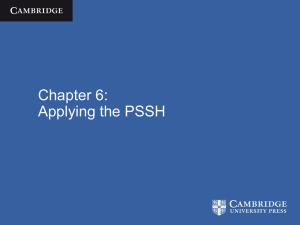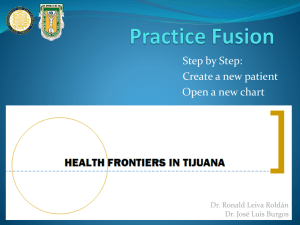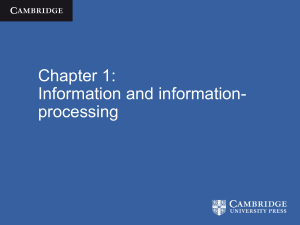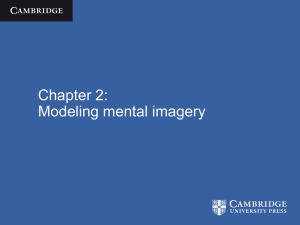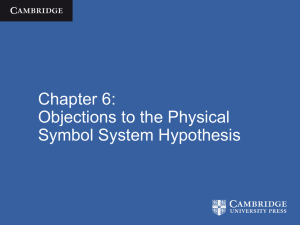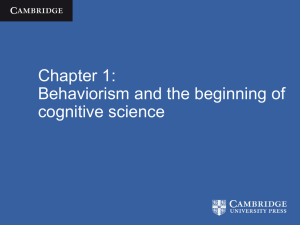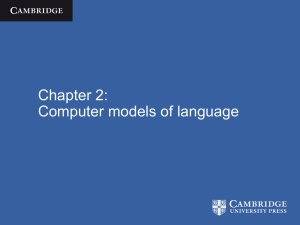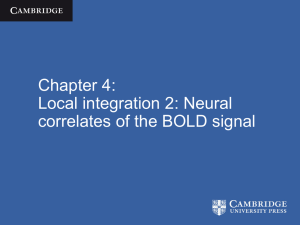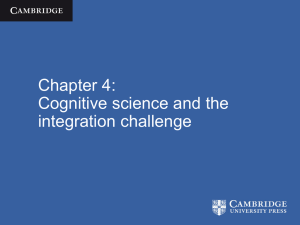Marr`s theory of vision
advertisement
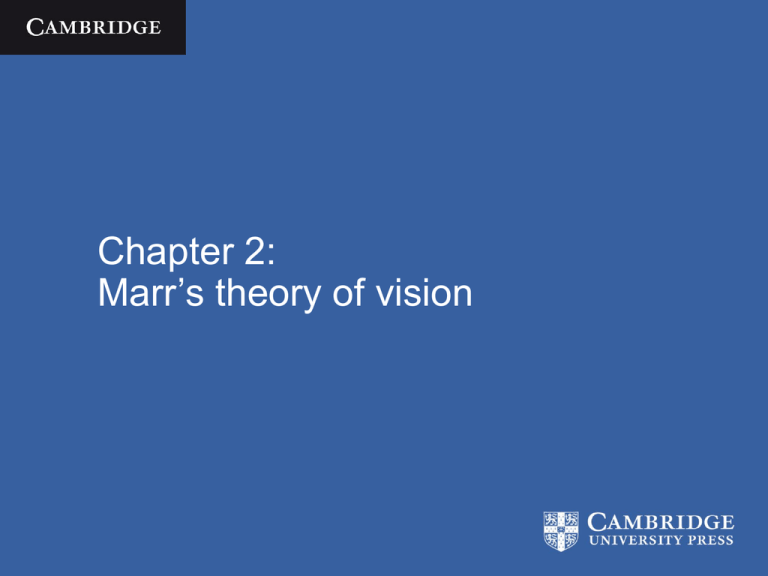
Chapter 2: Marr’s theory of vision Overview • Introduce Marr’s distinction between levels of explanation • Explain Marr’s top-down model of how the levels relate • Sketch out the basic elements of Marr’s theory of early vision Cognitive Science José Luis Bermúdez / Cambridge University Press 2010 Background • The different disciplines involved in cognitive science operate at very different levels and use different techniques • Experimental psychology • Computer science/AI • Theoretical perspectives from information theory and theory of computation Cognitive Science José Luis Bermúdez / Cambridge University Press 2010 Different levels • Miller’s psychophysics experiments explore the cognitive capacities and limitations of the subject • Broadbent’s information-processing model explores how information flows within and between various subpersonal subsystems and mechanisms • Kosslyn focusing on different ways of coding information • And we haven’t even started thinking about the brain. . . Cognitive Science José Luis Bermúdez / Cambridge University Press 2010 Marr’s approach • Distinguished different explanatory tasks at different levels • Gave a general theoretical framework for combining them • Apply the framework in considerable detail to a single example the early visual system Cognitive Science José Luis Bermúdez / Cambridge University Press 2010 Marr’s three levels • 3 different types of analysis of an information-processing system • Computational • Algorithmic • Implementational Cognitive Science José Luis Bermúdez / Cambridge University Press 2010 Computational analysis • Form of task analysis of a cognitive system • • (a) Identifies the specific information-processing problem that the system is configured to solve (b) Identify general constraints upon any solution to that problem Cognitive Science José Luis Bermúdez / Cambridge University Press 2010 Algorithmic analysis • Explains how the cognitive system actually performs the information-processing task • identifies input information and output information • identifies algorithm for transforming input into required output • specifies how information is encoded Cognitive Science José Luis Bermúdez / Cambridge University Press 2010 Implementational analysis • Finds a physical realization for the algorithm • Identify neural structures realizing the basic representational states to which the algorithm applies [e.g. populations of neurons] • Identify neural mechanisms that transform those representational states according to the algorithm Cognitive Science José Luis Bermúdez / Cambridge University Press 2010 Cognitive Science José Luis Bermúdez / Cambridge University Press 2010 Turing machine example • Computational Characterization of multiplication function • Algorithmic Turing machine table • Implementational physical Construction of a Turing machine Cognitive Science José Luis Bermúdez / Cambridge University Press 2010 Marr’s computational analysis of visual system • Two basic conclusions from his task analysis • The visual system’s job is to provide a 3D representation of the visual environment that can serve as input to recognition and classification processes – primarily information about shape of objects and their spatial distribution • This 3D representation is on an object-centered rather than viewer-centered frame of reference Cognitive Science José Luis Bermúdez / Cambridge University Press 2010 Experimental evidence • Possibility of double dissociations between perceptual abilities and recognitional abilities • Right parietal lesions – recognition abilities preserved, but problems in perceiving shapes from unusual perspectives • Left parietal lesions - shape perception intact, but recognition and identification impaired • Suggested to Marr that visual system provides input to recognition systems Cognitive Science José Luis Bermúdez / Cambridge University Press 2010 Theoretical considerations • Recognitional abilities are constant across changes in how things look to the perceiver due to • orientation of object • its distance from perceiver • partial occlusion by other objects • So - visual system provides information to recognition systems that abstracts away from these perspectival features – observer-independent representation Cognitive Science José Luis Bermúdez / Cambridge University Press 2010 Algorithmic analysis • Input = light arriving at retina • Output = 3D representation of environment • Questions: • what sort of information is extracted from the light at the retina? • how does the system get from this information to a 3D representation of the environment? Cognitive Science José Luis Bermúdez / Cambridge University Press 2010 The challenge • “From an information-processing point of view, our primary purpose is to define a representation of the image of reflectance changes on a surface that is suitable for detecting changes in the image’s geometrical organization that are due to changes in the reflectance of the surface itself or to changes in the surface’s orientation or distance from the viewer” (Marr, Vision p. 44) • Need to find representational primitives that allow inference backwards from structure of image to structure of environment Cognitive Science José Luis Bermúdez / Cambridge University Press 2010 Representational primitives • Basic information at retina = intensity value of light at each point in the retinal image • changes in intensity value provide clues as to surface boundaries • Primitives allow structure to be imposed on patterns of intensity changes • E.g. zero crossings (sudden intensity changes) Cognitive Science José Luis Bermúdez / Cambridge University Press 2010 Zero crossings • If we plot changes in intensity on a graph, then radical discontinuities will be signalled by the curve crossing zero • Marr proposed a Laplacian/Gaussian filter to detect zero crossings Cognitive Science José Luis Bermúdez / Cambridge University Press 2010 Primal sketch • identifies intensity changes in the 2D image • basic information about the geometric organization of those intensity changes • Primitives include: zero-crossings virtual lines groups Cognitive Science José Luis Bermúdez / Cambridge University Press 2010 2.5D sketch • Displays orientation of visible surfaces in viewer-centered coordinates • Represents distance of each point in visual field from viewer • Also orientation of each point and contours of discontinuities • Very basic information about depth Cognitive Science José Luis Bermúdez / Cambridge University Press 2010 3D sketch • characterizes shapes and their spatial organization • object-centered • basic volumetric and surface primitives are schematic (facilitates recognition) Cognitive Science José Luis Bermúdez / Cambridge University Press 2010 Representation in the 3D sketch • depends upon many shapes being recognizable as ensembles of generalized cones • Generalized cones are easy to represent • vector describing path of the figures axis of symmetry • vector specifying perpendicular distance from every point on axis to shape’s surface Cognitive Science José Luis Bermúdez / Cambridge University Press 2010 Cognitive Science José Luis Bermúdez / Cambridge University Press 2010 Basic top-down assumption • Explanation is top-down because of underdetermination • Many different algorithms can in principle compute the same task • There are many different ways of implementing a given algorithm • Multiple realizability more informative to work at higher levels • Relatively little implementational detail in Marr Cognitive Science José Luis Bermúdez / Cambridge University Press 2010 Implementing zero crossings Cognitive Science José Luis Bermúdez / Cambridge University Press 2010 Marr key points 1) Trilevel hypothesis very influential 2) Classic example of top-down analysis 3) Most detail comes at algorithmic level 4) Neurobiology only comes in at the implementational level Cognitive Science José Luis Bermúdez / Cambridge University Press 2010
